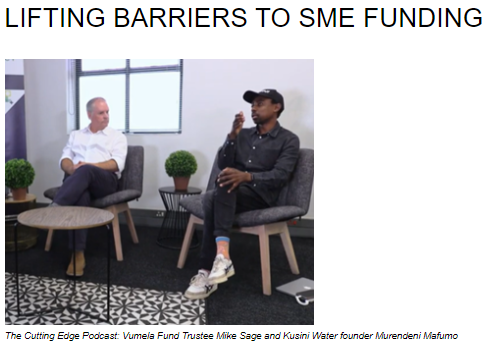In many countries around the world, it is difficult for SMEs to raise capital for starting a business. In developed countries, people are able to turn to some form of generational wealth and are able to access capital through friends and families to execute their business ideas. Most entrepreneurs and aspiring entrepreneurs in South Africa, unfortunately, do not have that as an option, which is why it is important for us to find ways to assist in the development of SMEs through funding mechanisms
In a recent episode of The Cutting Edge, a podcast series hosted by Edge Growth, Vumela Fund Trustee Mike Sage and Kusini Water founder Murendeni Mafumo explored ways to lift barriers to funding and unlock capital for more of South Africa’s SMEs. Providing a dual perspective on the complexities of capital raising, Mike Sage presented an investor’s outlook, complemented by the learnings of Murendeni Mafumo obtained through first-hand experience as a founder in pursuit of access to funding.
Murendeni Mafumo developed water filtration technologies that help take water from any source, except seawater, and turn it into drinkable water. Murendeni’s company Kusini Water, headquartered in Johannesburg, supplies communities, companies, and individuals in several provinces with clean water, and since November last year, has been producing 5-million liters of water every month. Murendeni shared how he funded his projects in their initial stages through grant funding, however, he then faced challenges when it came to bridging capital, and how to access other funding to grow from there.
So many young businesses are looking for access to capital. The biggest challenge for funders is accurately assessing what businesses work and the best use of capital over time. Mike Sage shared some tips on how this information should be structured in order to increase the chances of the SME being successful in their fundraising efforts.
It is important to ensure that your product/service offering and business model is straight forward and easy to understand in the eyes of the prospective investor. Mike emphasized that any business trying to raise capital needs to clearly communicate this. The investor needs a holistic and concise understanding of what you are offering where they can see how exactly the capital will be used and how they will get their return on investment.
SMEs also need to ensure that they have their legalities in order before approaching the bank or venture capitalists for funding. Having a registered business entity makes it easier for prospective investors to establish track record..
One major mistake many SMEs make is not having a financial framework in place to show potential investors that they are capable of creating and managing a cash flow stream. Prospective funders need to see that you already have systems in place to generate revenue and receive payments, and how you manage that..
If an SME has a proven track record with corporate clients who can vouch for their product and quality of service, this can also help in making the SME an attractive investment opportunity to potential funders. If you can show that you have real and credible people already buying your products who are happy with your service, it will demonstrate traction and give the investor more confidence.
Mike adds that SMEs often underestimate what grant funding can do for them. This option does not always offer large amounts of capital, or the full capital required by the business, but can however allow you to get to a place where your business looks investable in that it would have ticked all of the above boxes of what debt funders are looking for when considering investing in your business.
Murendeni said that when his company got grant funding as the business was growing, they did not use this capital to try out new things, but they used it on products they knew would work in the market. Grant funding also allows debt investors to see how you make financial decisions and manage capital.
In a nutshell, SMEs can position themselves for fundraising success by ensuring that they have a solid and investable product and business model before coming up with fundraising strategies. SMEs should look for grant funding opportunities before resorting to debt funding. After grant funding, the next step would be to approach the bank, even if all they can give you is a small lending facility.
Once you have shown the ability to manage the little that you have, you can really start utilising more funding mechanisms to propel you to the next level. As a result, more businesses successfully transition from start-ups to solid businesses where raising capital is no longer an issue.
Edge Growth has developed a podcast series to address a range of topics with various subject matter experts to unpack solutions to address barriers to SME Development. Listen to the full podcast here.


